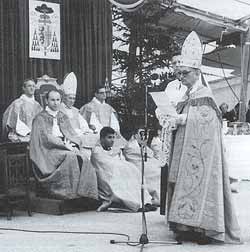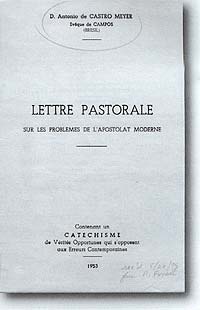Pastoral Letter: On The Problems Of The Modern Apostolate
Bishop Antonio de Castro Mayer

Bishop Antonio de Castro Mayer makes his Declaration during the Episcopal Consecrations at Econe
(June 30, 1988). Seated to the right of Archbishop Lefebvre is Fr. Rangel (now Bishop) in Campos.
Just behind Bishop de Castro Mayer's right shoulder is then Fr. Fernando Rifan.

For the first time in English, The Angelus will serialize On the Problems of the Modern Apostolate, the monumental pastoral letter of January 6, 1953, written by Bishop Antonio de Castro Mayer which identified modernist creep, crystallized the Church's teaching for his diocese (Campos, Brazil), and thereby saved clergy and faithful from the seduction of Vatican II.
Continuing what was begun in the December 2002 issue, we advance six more of Bishop de Castro Mayer's eighty True/False propositions which are classed into seven sections in the original letter: I. The Liturgy (1-13), II. The Structure of the Church (14-31); III. The Methods of the Apostolate (32-40); IV. The Spiritual Life (41-49); V. The New Morality (50-60); VI. Rationalism, Evolutionism, Laicism (61-65); VII. Relations Between Church and State (66-80).
Catechism of Opportune TRUTHS
Opposed to Contemporary ERRORS
|
5 TRUE One would be straying from the straight path were he to wish the altar restored to its primitive table-form (Mediator Dei, §62). |
FALSE The altar must be in the form of a table that recalls the Last Supper. |
|
Explanation: It is well to underline the doctrinal coherence that exists among the multiple propositions heretofore refuted. They proceed from the false supposition according to which the faithful participate in the priesthood of Jesus Christ in the same manner as priests do, although, perhaps, to a lesser degree. There is, however, a specific difference between these two participations which the Holy Father does not fear to compare to the difference that exists between the pagan and the baptized. Just as the pagan is outside the union of the Mystical Body of Christ, and inasmuch is incapable of any act proper to this Body, so also the simple layman is outside the priesthood proper to priests and is fundamentally incapable of any specifically priestly act (cf. AAS 39, p. 539). The refuted error was a Protestant novelty which the Jansenists strove to maintain in the bosom of the Church, goaded by the same desire to reform the Church from within so that, from a monarchic and aristocratic society it might become a democratic society. Bear in mind one of the propositions of the Synod of Pistoia condemned by the Bull Auctorem Fidel of Pius VI (Aug. 28, 1794):
|
|
|
6 TRUE All forms of adoration shown to the Blessed Sacrament constitute precious forms of piety, and, as such, must be encouraged. Although the reception of Communion during Mass must be recommended, reception of the Holy Eucharist outside Mass is a means of participating in the Eucharistic Sacrifice.1 |
FALSE Reception of Communion outside Mass, visits to the Blessed Sacrament, the cult of adoring the Sacred Species, perpetual adoration, Benediction of the Blessed Sacrament constitute extra-liturgical forms of piety, and as such must be, little by little, suppressed. |
| Explanation: The refuted sentence presupposes that all forms of private piety are superfluous, which constitutes an error condemned by Mediator Dei.2 It also renews the spirit of the propositions condemned by the Council of Trent in Canons 5, 6, and 7 of Session XIII.3 | |
|
7 TRUE The simultaneity of several Masses does not break the unity of the social Sacrifice of the Church. |
FALSE The simultaneous celebration of several Masses breaks the unity of the social Sacrifice. |
|
Explanation: "...[T]here are some who assert that priests cannot offer Mass at different altars at the same time, because, by doing so, they separate the community of the faithful and imperil its unity...." This proposition is condemned by Mediator Dei (§95). The reason is clear: each Sacrifice of the Mass only has value by its intrinsic relation to the Sacrifice of the Cross, which was one and valid for all times. In this way, while there may be several Masses celebrated, in fact, the Sacrifice still remains essentially one. The refuted sentence recalls the Jansenist error condemned by the Constitution Auctorem Fidei of Pius VI, August 28, 1974, No. 31, where it is said:
|
|
|
8 TRUE There is not the least objection to having other images on the altar with the crucifix, provided that they do not take the place reserved to it. |
FALSE On the altar, there must be no other image than the crucifix. |
| Explanation: The practice of placing images on the altar is fully consonant with Catholic doctrine on the cult that is due to the saints they represent. The refuted sentence is contrary to Mediator Dei, which recommends the exposition of the images of saints in churches for the edification of the faithful, and which reproves those who would remove them.5 The preoccupation expressed in this sentence is readily related to the Protestant error that there is only one Mediator, who does not tolerate any secondary mediator. | |
|
9 TRUE The liturgical prayer which is made in the Church's name according to the words and rites proposed by her can only be made by the priests or the religious on whom its recitation is incumbent. The prayer of the simple layman is always a private prayer whether its words be liturgical or extra-liturgical. |
FALSE When the faithful recite the Divine Office, they accomplish a liturgical act. |
|
10 TRUE The spiritual life of the faithful necessarily comprises not only participation in the Mass and the sacraments, but also acts of private piety, without which salvation is impossible. |
FALSE For their spiritual life and union with Jesus Christ, the faithful need only participate in liturgical functions by reciting the official prayers. |
|
Explanation: The refuted sentence was proscribed by Mediator Dei in this way:
Moreover, even to priests, whose duty it is to offer liturgical prayer, the Code of Canon Law recommends a fervent private piety (Canon 125, §2). [All references in Bishop de Castro Mayer's Pastoral Letter obviously refer to the 1917 Code of Canon Law and not the 1983 version.–Ed.] |
|
1. Mediator Dei.
2. AAS 39, pp. 565-6, 583.
3. Dz. 887-889. 4Dz l531.
4. AAS 39, pp. 582, 546.
5. Mediator Dei, §§29-30.
| previous |
